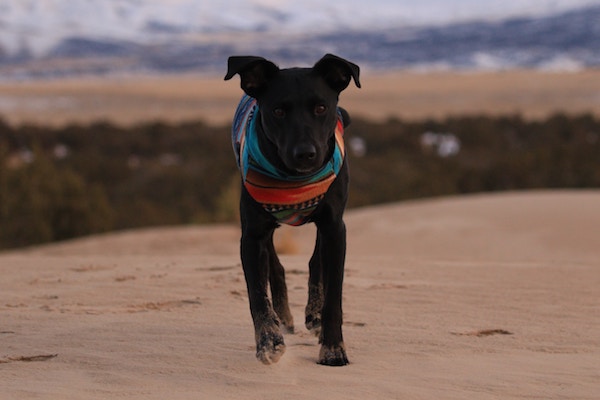Just like humans, our furry friends are affected by seasonal change. With winter well and truly upon us, it’s important to consider how your pet will fare in the cooler weather. There are certain precautions you can take to make sure they stay toasty warm. We’ve gathered together our top tips on keeping your fur-baby content in the cold.
Shelter and Sleep:
Outdoors:
Whether your pet is typically based indoors or outdoors will affect how you adjust their shelter and sleeping quarters for winter. For outdoor pets, it’s essential that their home-base is weather-proof and well protected from the elements. If a dog is exposed to cold and wet conditions for too long, their body temperature can drop dangerously low outdoor kennels off the ground, insulating doghouses with waterproof walls and rooves or moving your pet to a laundry or protected space are ideal wet-weather solutions. Line your kennel with plenty of blankets, but ensure that these are regularly dried and aired.
Indoors:
If your pet prefers the indoors, keep it cozy and move them to the most sun-drenched areas of the house. As with outdoor pets, elevating their bed above cold timber or concrete will reduce chills. Trampoline-style beds are an excellent choice because they allow dogs to get on and off the bed in a way that doesn’t exert excess pressure on their joints. Arthritis is a concern in winter, particularly for older dogs. If your pet spends long periods lying on cool or hard surfaces without regularly moving or struggles to get out of bed or up or down stairs, they are likely suffering from the cold. Most older dogs should be brought inside in winter to avoid shivering and increased arthritic pain. You can purchase joint support supplements to alleviate joint and muscle pain, but should consult your vet for the best course of treatment for your dog.
Avoid using hot-water bottles because they can overheat and burn unsuspecting pets. Instead, you can purchase microwave safe disks or ‘snuggle pads’ which can be placed under bedding. These are much safer than electric heating pads and are scratch and tear resistant. It’s crucial that you’re wary of external heating sources like log fires and heaters. Ensure heating is turned off when you’re not around and supervise your pet closely, training them to stay a safe distance away. Baby gates and fire guards are inexpensive solutions to saving your pet from burns. Should your pet suffer a burn, don’t use ice or ointments and instead apply a clean, sterile cloth to cool the area. Getting your pet to a vet as soon as possible is the best course of action.
Grooming and Fur-Fashion:
It’s time to break out your winter warmers – and your pet’s too! Coats and sweaters for dogs are a perfect way to ensure they stay snug. Choose one that covers the belly of your pet, in order to trap their body-heat and make it waterproof for best effect. Fit the coat to your pet, ensuring it’s not too tight or loose. The Thundershirt is also a popular choice during winter, particularly if your pet suffers from storm anxiety. The gentle pressure applied by the ‘shirt’ calms your dog’s nervous system and promotes anxiety-relieving properties.
If your pet is particularly small or old, a pair of booties can also be a great option. Have a dedicated water-repellent rain jacket that you regularly dry thoroughly, for exercising outdoors. If a pet stays in damp coats for too long, they risk a dropping body temperature and even organ failure.
Another important cool-weather solution, is proper grooming technique. Many of us assume pets will be kept toasty warm by their own fur, but this internal heating system doesn’t work when hair is knotted or tangled. To avoid this, brush your pet more in winter and perhaps introduce a de-tangler product into your grooming routine. This will remove dead hair and ensure fur doesn’t become matted. After bathing them in lukewarm water, thorough drying is very important so that there’s no dampness or residue. Consider professional grooming or furminators, which will strip dead fur without losing length that gives pets extra warmth.
Food, Drink and Vitamin D(ogs):
Your pet’s appetite is likely to increase in winter, as they burn more calories to stay warm. Outdoor animals are likely to require up to a 30% increase in food to compensate for the extra energy they need. If your pet stays indoors, they’re unlikely to need such an increase in food. Nutritional needs will vary between pets so ensure you get portions right by consulting with your vet. It’s also important to keep food room temperature in the cooler weather.
Like humans, pets may not be getting enough water during winter months. Ensure that you keep up with their needs by supplying fresh water. It’s best if this is warm (not hot). A great tip is to add some to their dinner, perhaps through a stock-cube added to some warm water, which has the added benefit of softening food for older pets.
Getting as much sunlight as possible is essential for pets. Like humans, exposure to the sun helps regulate mood and maintain a healthy, active routine. As much as we might want to hibernate in the cooler months, your fur baby needs regular exercise. Be wary that smaller or older pets may not be able to exert as much energy as normal and that you’re keeping your dog’s meals proportional with their exercise. If your pet has short fur, or if you’re walking in rain, a water-repellent jacket is a must.


Hi there, I love your article. Especially the part where warm water is needed. I absolutely agree with that. Thanks for sharing!